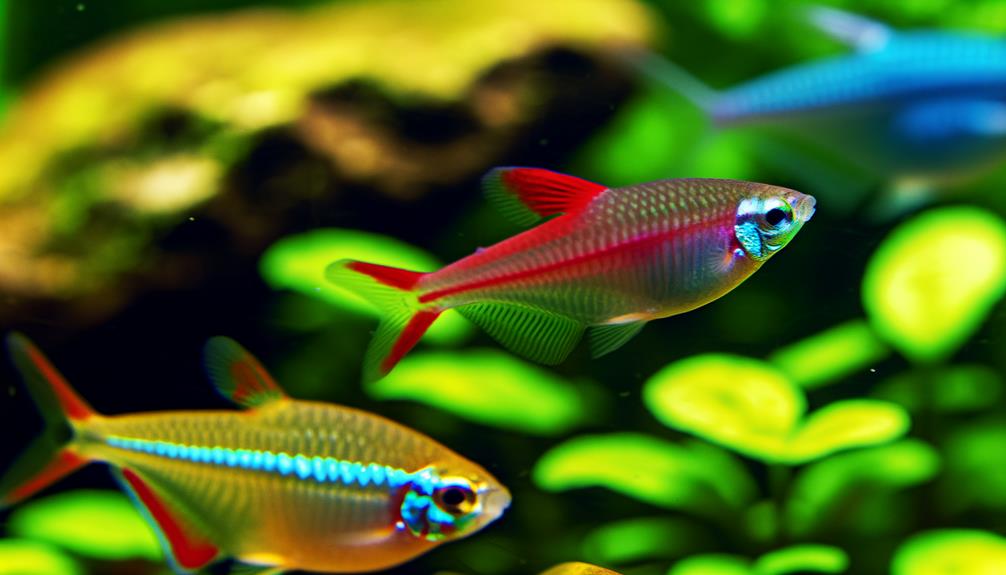How to Distinguish Between Male vs. Female Cardinal Tetras
To tell male Cardinal Tetras from females, look at their size and shape. Males are slimmer, reaching about 1.5 inches, while females can grow up to 2 inches and have rounder abdomens.
Males display more intense red and blue coloration with elongated, pointed dorsal and anal fins. In contrast, females have broader, rounded pelvic fins.
Behaviorally, males exhibit vibrant mating displays and lead school dynamics. Females provide stability, aiding in social cohesion.
Observing these traits helps you maintain a balanced aquarium. Discovering more about these differences enhances your understanding of their care and breeding.

Key Takeaways
- Males are slimmer and exhibit brighter red and blue hues compared to the larger, rounder females.
- Males have elongated dorsal and anal fins, while females have broader, rounded pelvic fins.
- Female cardinal tetras display a fuller abdomen and more pronounced body depth.
- The black stripe on males runs the full length of their body, but on females, it stops at the caudal peduncle.
- Males exhibit vibrant mating displays and lead the school, while females provide stability by following male leadership.
Size Differences
Have you ever noticed that male and female cardinal tetras exhibit slight size differences?
Males tend to be slightly smaller, typically reaching around 1.5 inches in length. In contrast, females can grow up to 2 inches. This size variation is subtle but consistent across the species. It's vital for accurate sex identification, especially in breeding scenarios.
You'll observe that these differences become more pronounced during the spawning season when females appear fuller due to egg development.
Understanding these size distinctions can enhance your ability to maintain a balanced aquarium ecosystem. By recognizing and accounting for these differences, you can better manage feeding routines, tank space, and overall health monitoring, ensuring a thriving environment for your cardinal tetras.
Body Shape
In addition to size differences, male and female cardinal tetras also exhibit distinct variations in body shape. You'll notice that males typically have a slimmer, more streamlined profile, which aids in their agility and speed.
Females, on the other hand, generally display a rounder, fuller abdomen, especially noticeable when they're gravid with eggs. This differentiation in body shape is due to reproductive roles, with females needing extra space for egg development.
Observing these characteristics can help you accurately determine the sex of your cardinal tetras. When examining your fish, focus on the overall contours and abdominal fullness. These subtle yet clear distinctions in body shape are essential for ensuring proper pairing and understanding of their reproductive behaviors.
Color Variations
When distinguishing between male and female cardinal tetras, you'll observe that males often display more vibrant and intense coloration than their female counterparts. Males typically exhibit brighter and more saturated red and blue hues, which can be a primary indicator of gender.
Females, on the other hand, usually have slightly duller and less intense colors. This difference in coloration is attributed to the males' need to attract females during the mating process. Additionally, the red stripe running along the males' bodies tends to be more pronounced and extends into a sharper point.
Fin Characteristics
Observing the fin characteristics of cardinal tetras reveals distinct differences between males and females. You'll notice these variations primarily in the dorsal, anal, and pelvic fins.
- Dorsal Fin:
Male cardinal tetras typically have a more elongated and pointed dorsal fin compared to females. This feature is useful for distinguishing between the sexes.
- Anal Fin:
The anal fin in males also tends to be more extended and sharper than in females, showcasing a sleek, streamlined appearance.
- Pelvic Fin:
Females usually exhibit a broader, more rounded pelvic fin, contrasting with the males' narrower, pointed fins.
These fin characteristics serve as reliable indicators for sexing your cardinal tetras, aiding in accurate identification and breeding practices.
Behavioral Traits
You can observe distinct behavioral traits between male and female Cardinal Tetras.
Males often exhibit more vibrant mating displays, characterized by specific fin movements and body postures. Additionally, their social interaction patterns may include more frequent territorial behaviors compared to females.
Social Interaction Patterns
Male and female cardinal tetras exhibit distinct behavioral traits in their social interaction patterns within a community tank. Understanding these differences can help you maintain a harmonious aquarium environment.
- Schooling Behavior:
- Males often lead the school, showing more dominant and exploratory actions.
- Females generally follow, providing stability to the group.
- Territoriality:
- Males display mild territorial behavior, especially around prime swimming areas.
- Females are more passive and less likely to engage in territorial disputes.
- Feeding Dynamics:
- During feeding, males tend to be more aggressive and competitive, securing food quickly.
- Females are slightly more reserved but efficient feeders.
Mating Display Differences
In addition to their social interaction patterns, cardinal tetras exhibit distinct mating display behaviors that can help differentiate males from females.
You'll observe that males perform elaborate courtship displays, including rapid darting movements and flaring of their fins to attract females. Males often assume a more vibrant coloration during these displays, enhancing their visual appeal.
Females, on the other hand, are less active in their displays and show more muted colors. They typically respond to male advances with subtle body movements, signaling receptivity.
When the female is ready to spawn, she'll swim close to the male, leading to synchronized swimming patterns. Understanding these behavioral traits can aid in accurately identifying the sexes within your cardinal tetra population.
Breeding Indicators
You can identify breeding indicators in cardinal tetras by observing distinct color patterns, behavioral differences, and spawning preparations.
Males typically exhibit more vibrant hues compared to females. Additionally, observe changes in swimming behavior and nesting activities as signs of readiness for spawning.
Distinct Color Patterns
When examining cardinal tetras for breeding purposes, distinct color patterns become essential indicators of their sex. You'll notice that males and females exhibit subtle differences in their coloration. These distinctions help you accurately identify and select breeding pairs.
- Intensity of Blue Stripe:
Males generally display a more intense and vivid blue stripe running along their bodies compared to females.
- Red Area Extent:
The red area on males often extends further towards the front of their bodies than on females.
- Body Shape and Color Contrast:
Males have a slender body with sharper color contrasts, while females usually have a rounder, fuller body shape, which may cause the colors to appear slightly muted.
Understanding these patterns allows you to make informed breeding decisions.
Behavioral Differences
Male and female cardinal tetras demonstrate distinctive behavioral patterns during breeding, which can act as reliable indicators for sex differentiation. Males tend to participate in more frequent and elaborate courtship displays, including swift swimming and fin flaring to attract females. You'll notice males chasing females, showcasing their agility and vivid coloration.
Females, on the other hand, exhibit more subdued behavior, often swimming more slowly and displaying less vibrant coloration. During breeding, females may also appear more rounded due to egg development. Observing these behaviors can provide clear differentiation between sexes, assisting in successful breeding efforts.
Understanding these behavioral cues is essential for maintaining ideal conditions for cardinal tetras, ensuring a healthy and thriving aquatic environment.
Spawning Preparations
Regularly observing the physical and environmental conditions can help identify key breeding indicators in cardinal tetras. You'll want to look for subtle changes that signal readiness for spawning.
Here are three vital indicators:
- Color Intensity: Males often exhibit brighter, more vibrant colors compared to females. This heightened coloration signals their readiness to attract mates.
- Behavioral Changes: Increased activity, including chasing and displaying behaviors, suggests that males are preparing for spawning.
- Abdominal Swelling: Females develop a noticeable roundness in their abdomen as they fill with eggs, indicating they're preparing to spawn.
Monitoring these indicators can provide valuable insights into the spawning readiness of your cardinal tetras, ensuring ideal breeding conditions and timing.
Habitat Preferences
Cardinal tetras thrive in densely planted habitats with soft, acidic water and subdued lighting. You should replicate these conditions to maximize their well-being. Aim for a pH range of 4.5-6.5 and water hardness below 4 dGH. Use plants like Java moss and Amazon swords to provide cover and imitate their natural environment. Maintain water temperatures between 73°F and 81°F.
Avoid bright lighting; instead, use dim or indirect light to prevent stress. Ensure gentle water flow to imitate slow-moving river habitats. Use driftwood and leaf litter to create hiding spots and enhance biological filtration.
Conclusion
In distinguishing male from female cardinal tetras, you'll notice subtle yet telling differences: males tend to be slimmer, females rounder.
Males often exhibit slightly more vibrant coloration, while females may display a fuller abdomen, especially when ready to breed.
Pay attention to fin shapes and behavioral cues; they're significant. Observing these characteristics closely enhances your understanding of these fascinating fish, making your aquarium experience not just a hobby, but a scientific endeavor.
Knowledge fosters care, and attention promotes thriving tetras.






